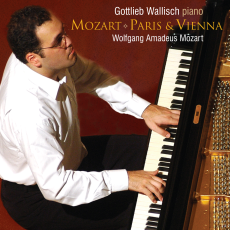Gottlieb Wallisch - Mozart: Paris & Vienna - Audio Video Club of Atlanta
Once again, it's a pleasure to listen to Gottlieb Wallisch playing Mozart. I previously reviewed his debut album for Linn Records, "Mozart in Vienna" in August, 2010, praising the transparency of his playing and the insight he brought into his interpretations. The superb clarity of purpose, sensitive touch on the keys, and feeling for the complexities of structure the Vienna native showed in his earlier album are present again in this latest release, "Paris & Vienna: a Tale of Two Cities." Though Mozart did, in fact write many of these piano works, including Sonatas 10 and 12, at home in Salzburg, they were clearly intended for the International stage. On the continent in those days, that meant the two cities of the title. Both sonatas lifted the sonata to new heights of virtuosity, transcending its origin as an instructional tool.
Sonatas Nos. 10 in C major, K330 and 12 in F major, K332 were both written within a short time of each other in 1778 (In between: K331, the sonata with the famous Rondo alla turca, but that's for another day and another album). Both bear similarities in their general outline and are generally optimistic and life-affirming, though the middle section of the Andante cantabile in K330 does seem surprisingly melancholy, an example of the sort of profundity that can steal upon the listener unawares when the subject is Mozart. The most remarkable movement of K332 is the finale, a rapid allegretto in 6/8 time that begins with a forte chord, soon giving way to rapid passagework, and concludes with a pianissimo cadence, one of Mozart's little surprises.
This pianist's marvelous feeling for lithe rhythms and seemingly effortless spontaneity is evident once again in the Allegro in B-flat major, K400, sole surviving movement of an unfinished sonata. Wallisch talks of its "frivolous virtuosity," and indeed that is the case, including a requirement for a dazzling display of finger dexterity that can leave the listener feeling agreeably dotty. The Fantasy in c minor, K396, begun by Mozart and finished by the Abbé Maximilan Stadler with a serious development and recapitulation that seem quite in character with its beginning, provides yet another opportunity for keyboard wizardry with such unusually small note values as the preponderance of triplet hemidemisemiquavers in its opening. (For years, I've longed to use that word in a review, and now I've finally had the chance. Thanks, Mozart!)
Sadness, sighing, profound mystery, and dissonance make up the world of the Adagio in B minor, K540. Wallisch does a wonderful job of pacing this remarkable outpouring of emotion that goes through a succession of moods, promising an enlightenment that is ultimately quashed, though the general mood is not as spectral or the chord progressions as wraithlike as I've heard in other interpretations.
The delightful Andante in F, K616, was originally written for mechanical organ, but, as Wallisch shows us here and in his account of the Paisiello Variations, K398, it is never safe to mistake Mozart's light tone and popular intent with mere superficiality.

